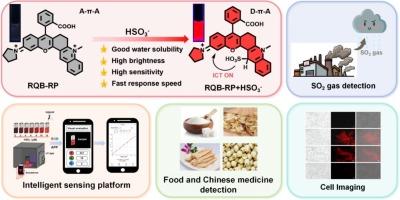A materialized intelligent sensing platform driven by ultra-sensitive fluorescent probe: Smart phone-assisted portable detection of SO2 and its derivatives
IF 4.6
2区 化学
Q1 SPECTROSCOPY
Spectrochimica Acta Part A: Molecular and Biomolecular Spectroscopy
Pub Date : 2025-09-20
DOI:10.1016/j.saa.2025.126974
引用次数: 0
Abstract
Sulfur dioxide (SO2) has long been recognized as an environmental pollutant, and excessive intake of SO2 and its derivatives (HSO3−/SO32−) is harmful to human health. In this paper, we report a specific recognition of HSO3− fluorescent probe RQB-RP, which exhibits color-enhancing and strong fluorescence activation, good water solubility, fast response (4 s), high fluorescence quantum efficiency (Ф = 21.87 %) and high sensitivity (detection limit = 120.66 nM), and has a strong potential for application. Furthermore, the probe RQB-RP was materialized and combined with a smartphone sensing platform to achieve on-site visual quantitative detection of HSO3− without the need for large-scale instrumentation. The RQB-RP also has the ability to accurately detect HSO3− levels in food and Chinese medicine samples to assess compliance and safety. Furthermore, RQB-RP's excellent biocompatibility has been successfully used for the in situ detection of endogenous and exogenous HSO3− in mitochondria of MCF-7 cells.

超灵敏荧光探针驱动的物化智能传感平台:智能手机辅助便携式二氧化硫及其衍生物检测
二氧化硫(SO2)一直被认为是一种环境污染物,过量摄入SO2及其衍生物(HSO3−/SO32−)对人体健康有害。本文报道了对HSO3−荧光探针RQB-RP的特异性识别,该探针具有显色性强、荧光活化强、水溶性好、响应快(4 s)、荧光量子效率高(Ф = 21.87%)和灵敏度高(检出限= 120.66 nM)等特点,具有很强的应用潜力。此外,将探针RQB-RP物化并与智能手机传感平台相结合,无需大型仪器即可实现HSO3−的现场视觉定量检测。RQB-RP还能够准确检测食品和中药样品中的HSO3−水平,以评估合规性和安全性。此外,RQB-RP优良的生物相容性已成功用于MCF-7细胞线粒体内源性和外源性HSO3−的原位检测。
本文章由计算机程序翻译,如有差异,请以英文原文为准。
求助全文
约1分钟内获得全文
求助全文
来源期刊
CiteScore
8.40
自引率
11.40%
发文量
1364
审稿时长
40 days
期刊介绍:
Spectrochimica Acta, Part A: Molecular and Biomolecular Spectroscopy (SAA) is an interdisciplinary journal which spans from basic to applied aspects of optical spectroscopy in chemistry, medicine, biology, and materials science.
The journal publishes original scientific papers that feature high-quality spectroscopic data and analysis. From the broad range of optical spectroscopies, the emphasis is on electronic, vibrational or rotational spectra of molecules, rather than on spectroscopy based on magnetic moments.
Criteria for publication in SAA are novelty, uniqueness, and outstanding quality. Routine applications of spectroscopic techniques and computational methods are not appropriate.
Topics of particular interest of Spectrochimica Acta Part A include, but are not limited to:
Spectroscopy and dynamics of bioanalytical, biomedical, environmental, and atmospheric sciences,
Novel experimental techniques or instrumentation for molecular spectroscopy,
Novel theoretical and computational methods,
Novel applications in photochemistry and photobiology,
Novel interpretational approaches as well as advances in data analysis based on electronic or vibrational spectroscopy.

 求助内容:
求助内容: 应助结果提醒方式:
应助结果提醒方式:


